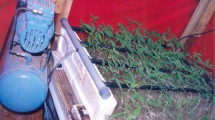Abstract
Seeds from two varieties of spring barley (Prisma and Camorgue) were grown axenically in water. After 14 days, the culture solutions contained organic P substances (about 4 μg P per plant) derived from root exudation, representing about 3% of the total P found in the seed. Gel filtration, separated the organic P into two well defined peaks, one with a high molecular weight (>45000 daltons) and the other with a low molecular weight (<500 daltons). The bioavailability of the soluble organic P released was assessed enzymatically and chemically. At the optimum pH of 5.0, phytase and acid phosphatase hydrolysed about 80% and 65%, respectively of the organic P in the exudate after 24 h whereas at the optimum pH of 9.8, alkaline phosphatase hydrolysed up to 40% P after the same length of time. In a pH 5.0 buffer, up to 10% of the organic P was hydrolysed compared with up to 45% in a pH 9.8 buffer. The high molecular weight organic P fraction recovered from the G-75 Sephadex behaved similarly.
Similar content being viewed by others
References
Anderson G (1980) Assessing organic phosphorus in soils. In: Kasawneh FE, Sample EC, Kamprath J (eds) The role of phosphorus in agriculture. Am Soc Agron Madison, Wis, pp 411–431
Barber DA, Martin JK (1976) The release of organic substances by cereal roots into soil. New Phytol 76: 69–80
Boero G, Thien S (1979) Phosphatase activity and phosphorus availability in the rhizosphere of corn roots. In: Harley JL, Russel RS (eds) The root-soil interface. Academic Press, London, pp 231–242
Chapin FS, Barsdate RJ, Barel D (1978) Phosphorus cycling in Alaskan coastal tundra: A hypothesis for the regulation of nutrient cycling. Oikos 31: 189–199
Chhonkar PK, Tarafdar JC (1981) Characteristics and location of phosphatases in soil-plant system. J Indian Soc Soil Sci 29: 215–219
Cosgrove DJ (1977) Microbial transformations in the phosphorus cycle. In: Alexander M (ed) Advances in microbial ecology. Plenum Press, New York, pp 95–135
Dalal RC (1978) Organic phosphorus. Adv Agron 29: 83–117
Foster RC (1985) In situ localization of organic matter in soils. Quaest Entomol 21: 609–633
Gardner WK, Barber DA, Parbery DG (1983) Non-infecting rhizosphere microorganisms and the mineral nutrition of temperate cereals. J Plant Nutr 6: 185–199
Gerritse RG, vanDijk H (1978) Determination of phosphatase activities of soils and animal wastes. Soil Biol Biochem 10: 545–551
Graham JH, Leonard RT, Menge JA (1981) Membrane-mediated decrease in root exudation responsible for phosphorus inhibition of vesicular-arbuscular mycorrhizal formation. Plant Physiol 68: 548–552
Holm BJ, Stewart JWB, Halstead RL (1972) The phosphorus cycle in a native grassland ecosystem. In: Isotopes and radiation in soil palnt relations including forestry. Int Atomic Energy Agency, Vienna, pp 571–586
Husz GS (1977) Agro-ecosystems in South America. Agro-Ecosystems 4: 277–292
Jones DL, Darrah PR (1992) Re-sorption of organic components by roots ofZea mays L. and its consequences in the rhizosphere. Plant and Soil 143: 259–266
Juma NG, Tabatabai MA (1978) Distribution of phosphomonoesterases in soils. Soil Sci 126: 101–108
Ladd JN, Foster RC, Skjemstad JO (1993) Soil structure; carbon and nitrogen metabolism. Geoderma 56: 401–434
Marschner H (1991) Plant-soil relationships: Acquisition of mineral nutrients by roots from soil In: Porter JR, Lawlor DW (eds) Plant growth interactions with nutrition and environment. Cambridge University Press, Cambridge, pp 125–155
McLaughlin MJ, Alston AM, Martin JK (1986) Measurement of phosphorus in the soil. Microbial biomass: A modified procedure for field soils. Soil Biol Biochem 18: 437–443
Miller RH, Schmidt EL (1965) Uptake and assimilation of amino acids supplied to the sterile soil: Root environment of the bean plant (Phaseolus vulgaris). Soil Sci 100: 300–323
Murphy J, Riley JP (1962) A modified single solution method for the determination of phosphate in natural waters. Anal Chim Acta 27: 31–36
Pasqualini S, Panara F, Antonielli M (1992) Acid phosphatase activity inPinus pinea — Tuber albidum ectomycorrhizal association. Can J Bot 70: 1377–1383
Pederson NEJ (1953) On phytin phosphorus in the soil. Plant and Soil 4: 252–266
Schönwitz R, Ziegler H (1982) Exudation of water-soluble vitamins and of some carbohydrates by intact roots of maize seedlings (Zea mays L.) into a mineral nutrient solution. Z Pflanzenphysiol 107: 7–14
Speir TW, Ross DJ (1978) Soil phosphatase and sulphatase. In: Burns RG (ed) Soil enzymes. Academic Press, London, pp 197–250
Tarafdar JC, Chhonkar PK (1978) Status of phosphatases in the root-soil interface of leguminous and non-leguminous plants. Z Pflanzenernaehr Bodenkd 141: 347–351
Tarafdar JC, Claassen N (1988) Organic phosphorus compounds as a phosphorus source for higher plants through the activity of phosphatases produced by plant roots and microorganisms. Biol Fertil Soils 5: 308–312
Tarafdar JC, Jungk A (1987) Phosphatase activity in the rhizosphere and its relation to the depletion of soil organic phosphorus. Biol Fertil Soils 3: 199–204
Tate KR (1985) Soil phosphorus. In: Vaughan D, Malcolm RE (eds) Soil organic matter and biological activity. Martinus Nijhoff, Dordrecht, pp 329–377
Vaughan D, MacDonald RI, (1971) Effects of humic acid on protein synthesis and ion uptake in beet disks. J Exp Bot 22: 400–410
Vaughan D, Ord BG (1991) Extraction of potential allelochemicals and their effects on root morphology and nutrient contents. In: Atkinson D (ed) Plant root growth. Blackwell, Oxford, pp 399–421
Vaughan D, Ord BG, Malcolm RE (1978) Effect of soil organic matter on some root surface enzymes of and uptakes into winter wheat. J Exp Bot 29: 1337–1344
Vaughan D, Jones D, Ord BG (1993) Amelioration byVolutella ciliata of the phytotoxicity of vanillic acid towards the growth ofPisum sativum L. Soil Biol Biochem 25: 11–17
Author information
Authors and Affiliations
Rights and permissions
About this article
Cite this article
Pant, H.K., Vaughan, D. & Edwards, A.C. Molecular size distribution and enzymatic degradation of organic phosphorus in root exudates of spring barley. Biol Fert Soils 18, 285–290 (1994). https://doi.org/10.1007/BF00570630
Received:
Issue Date:
DOI: https://doi.org/10.1007/BF00570630



